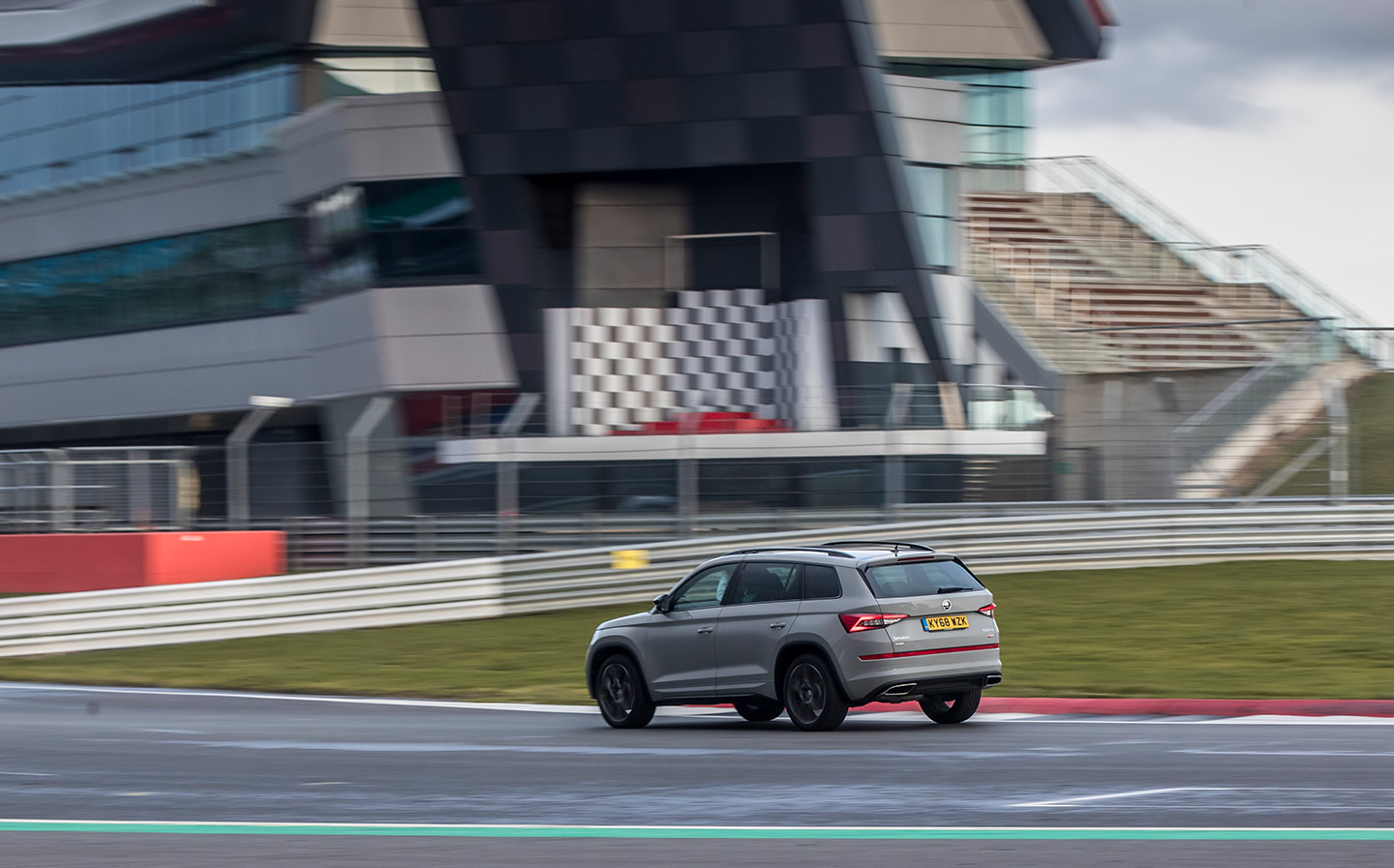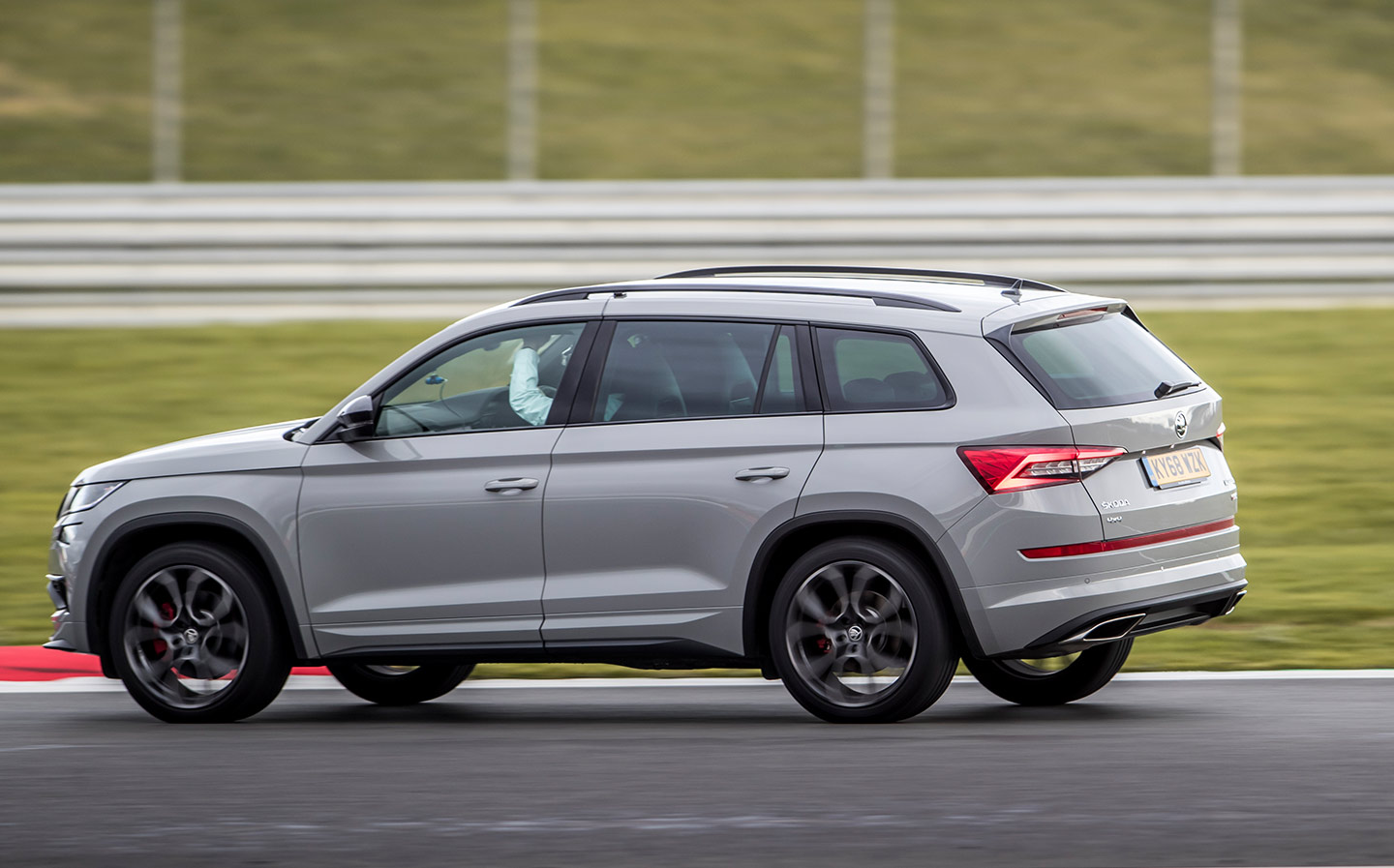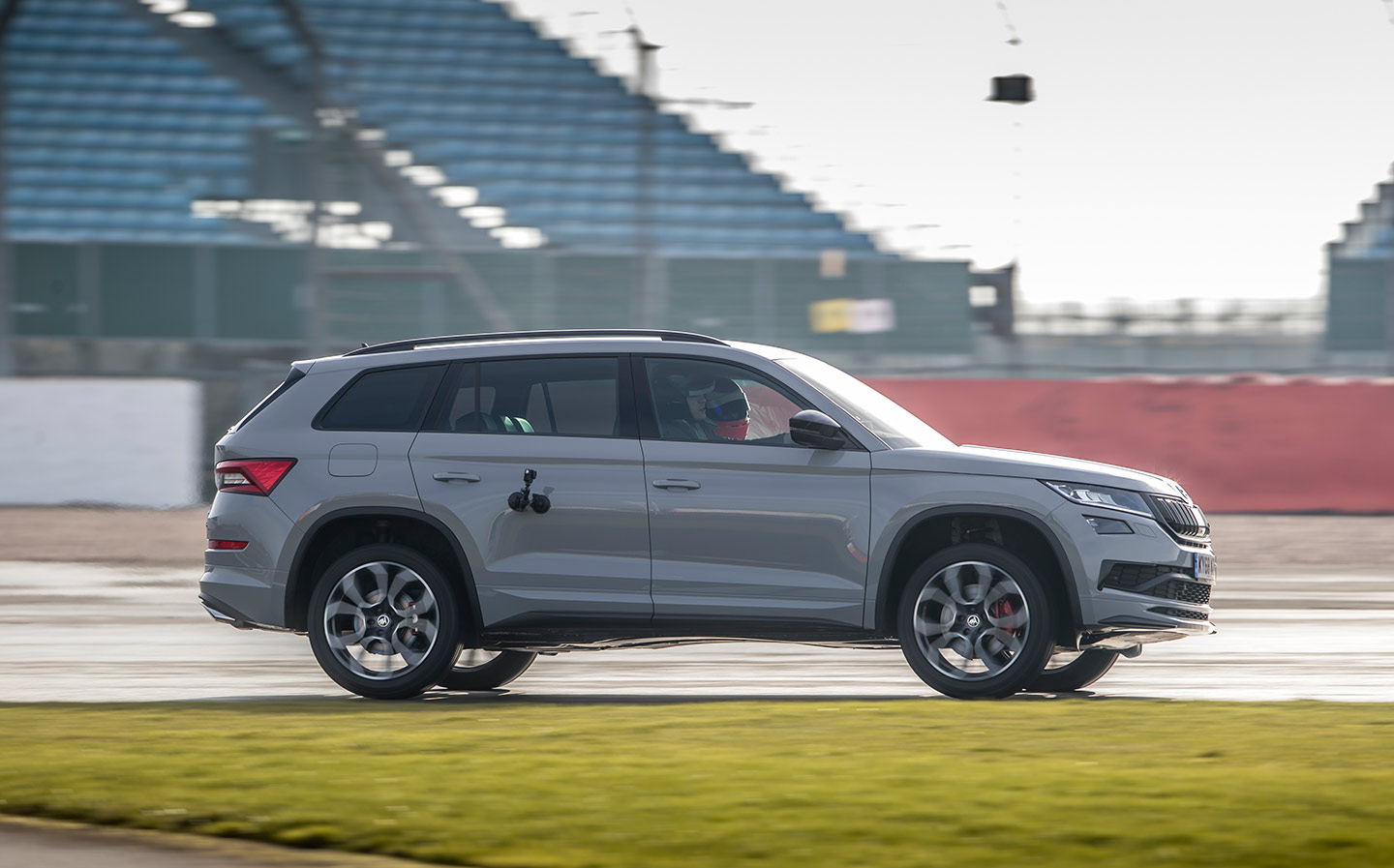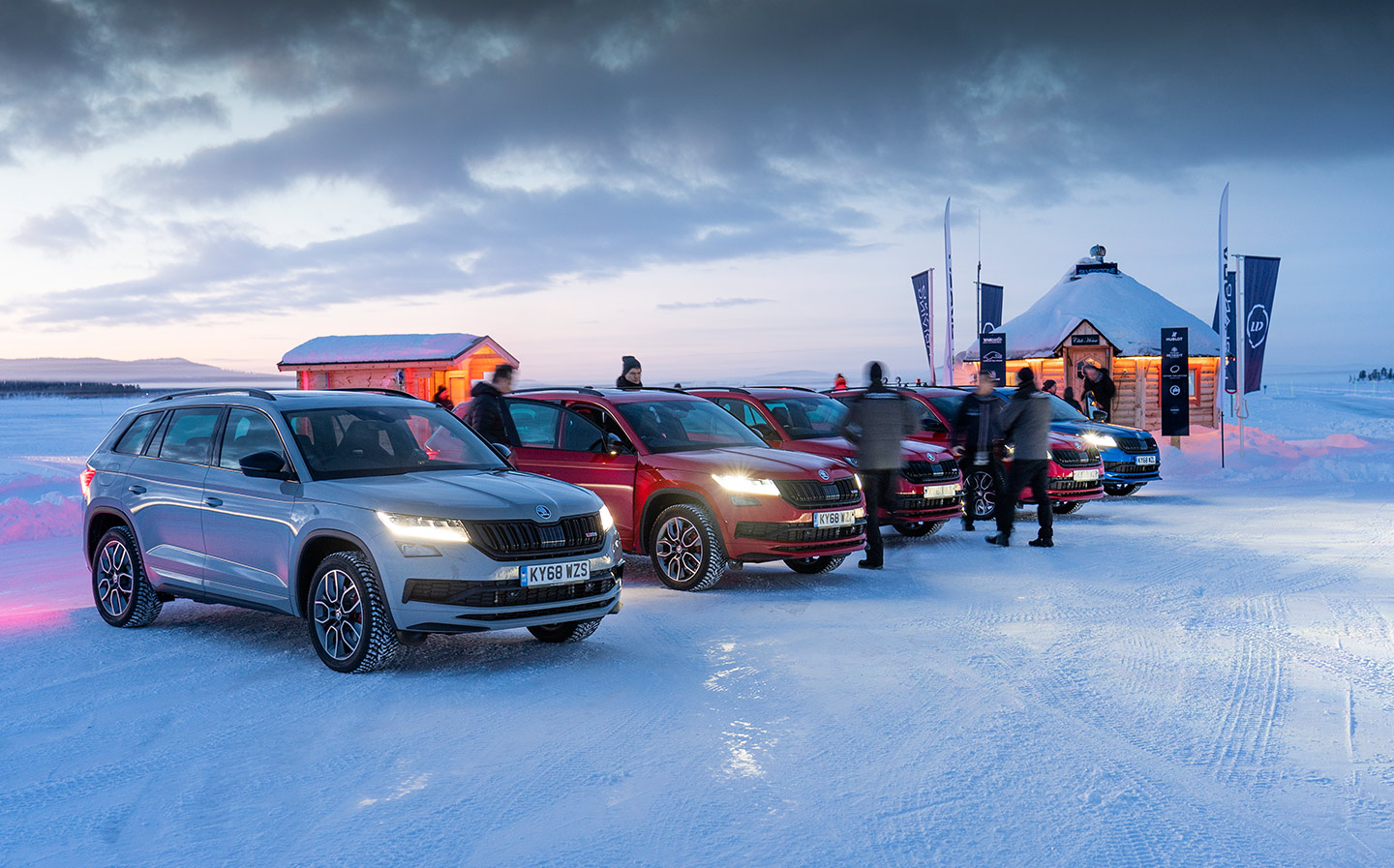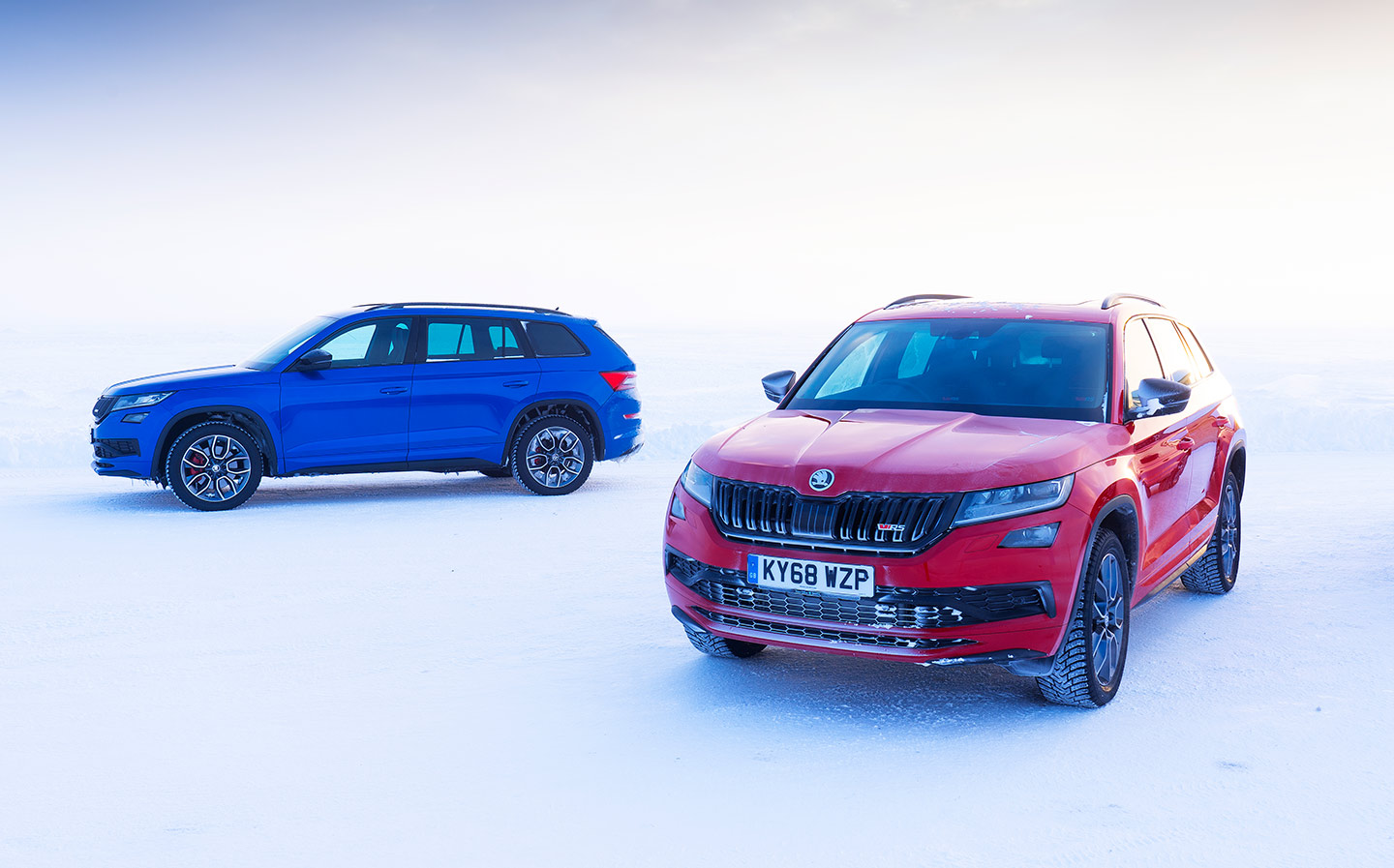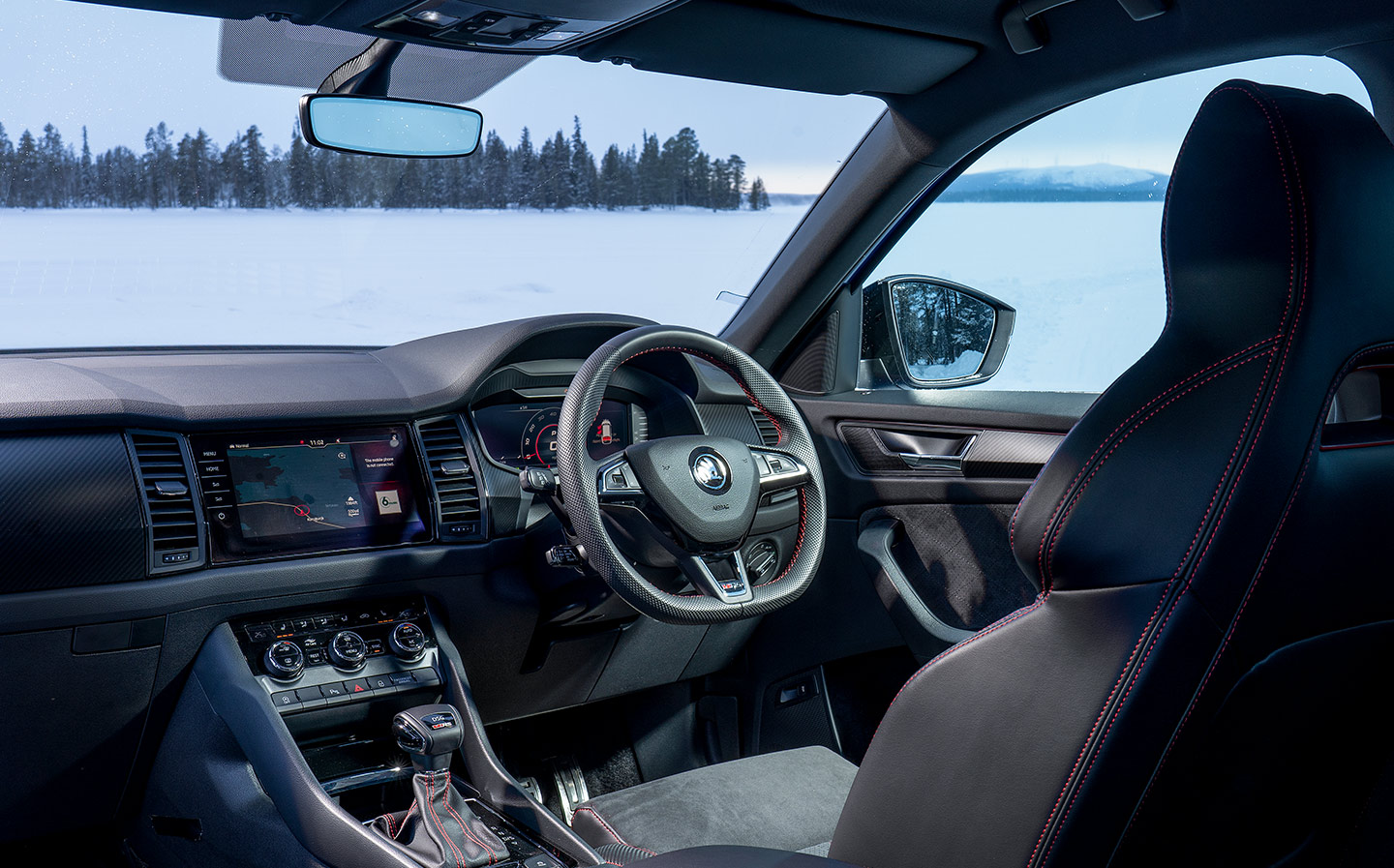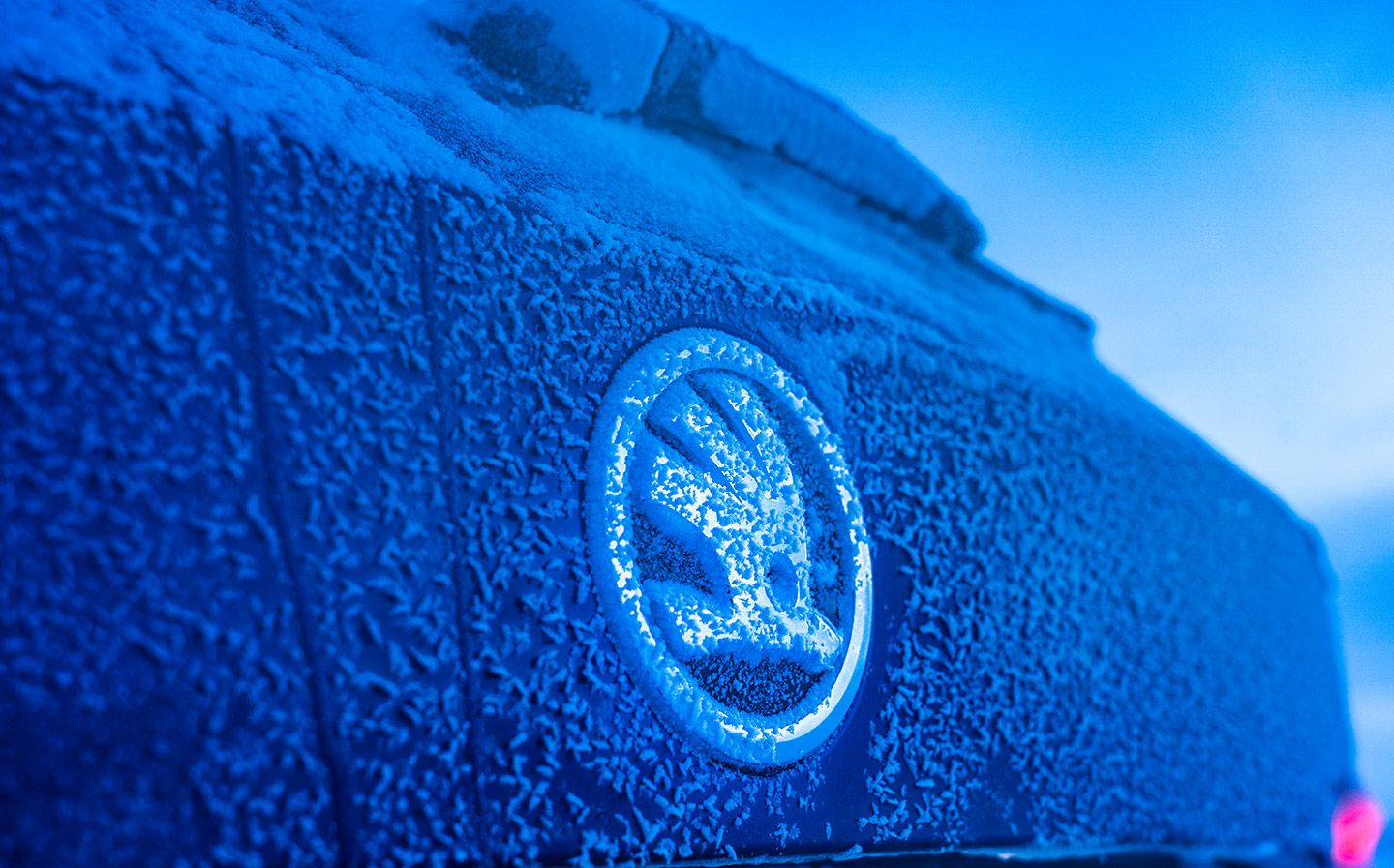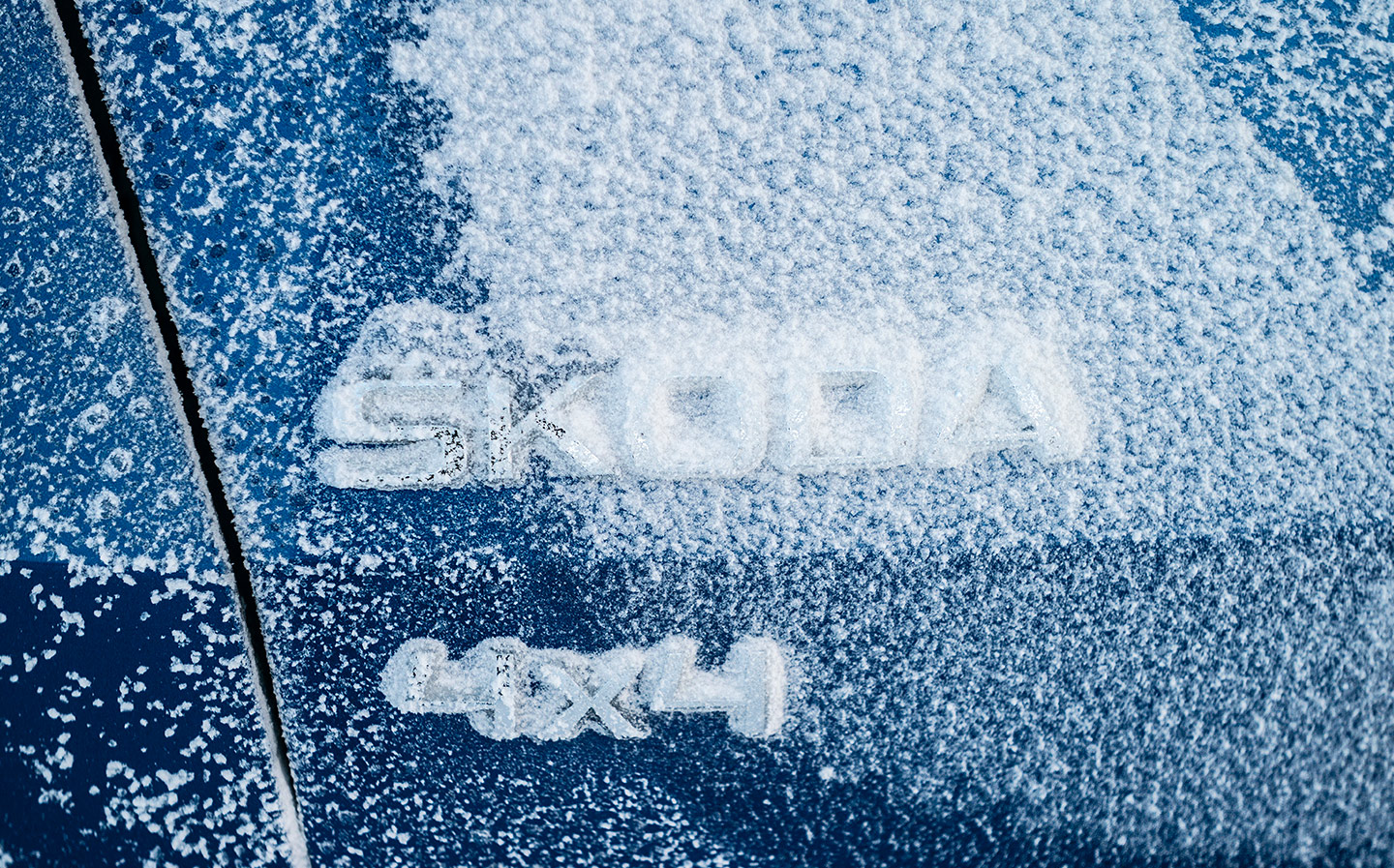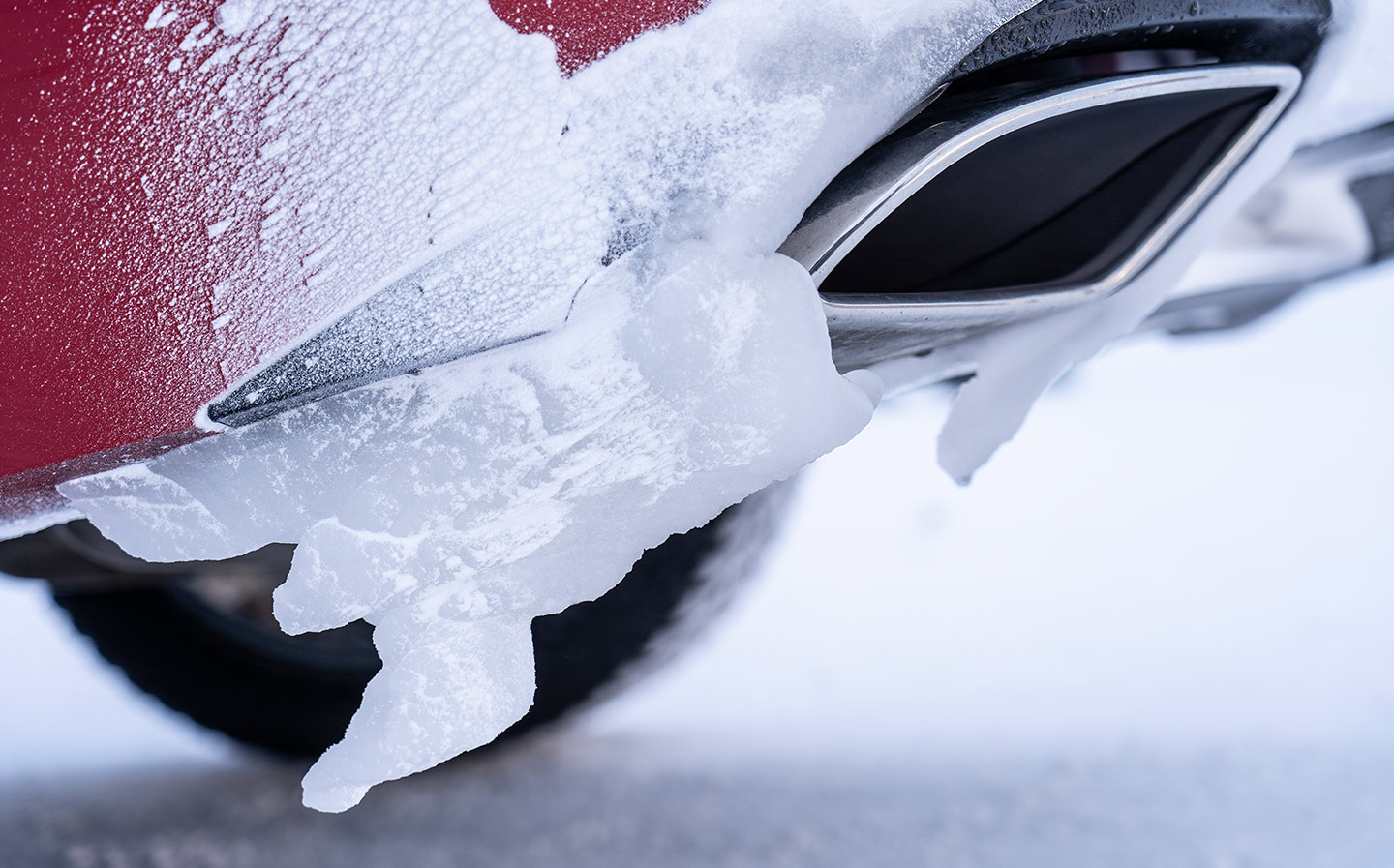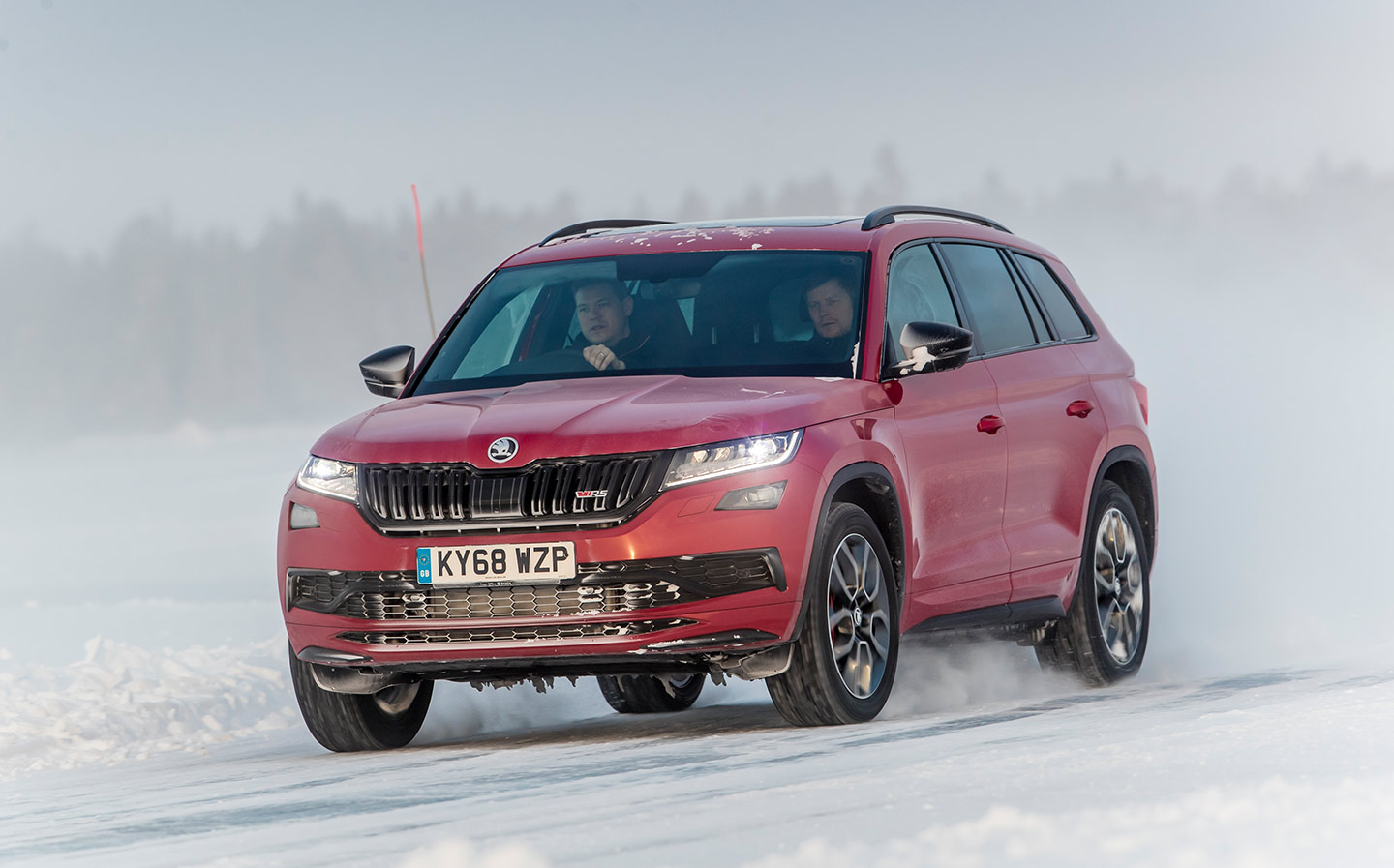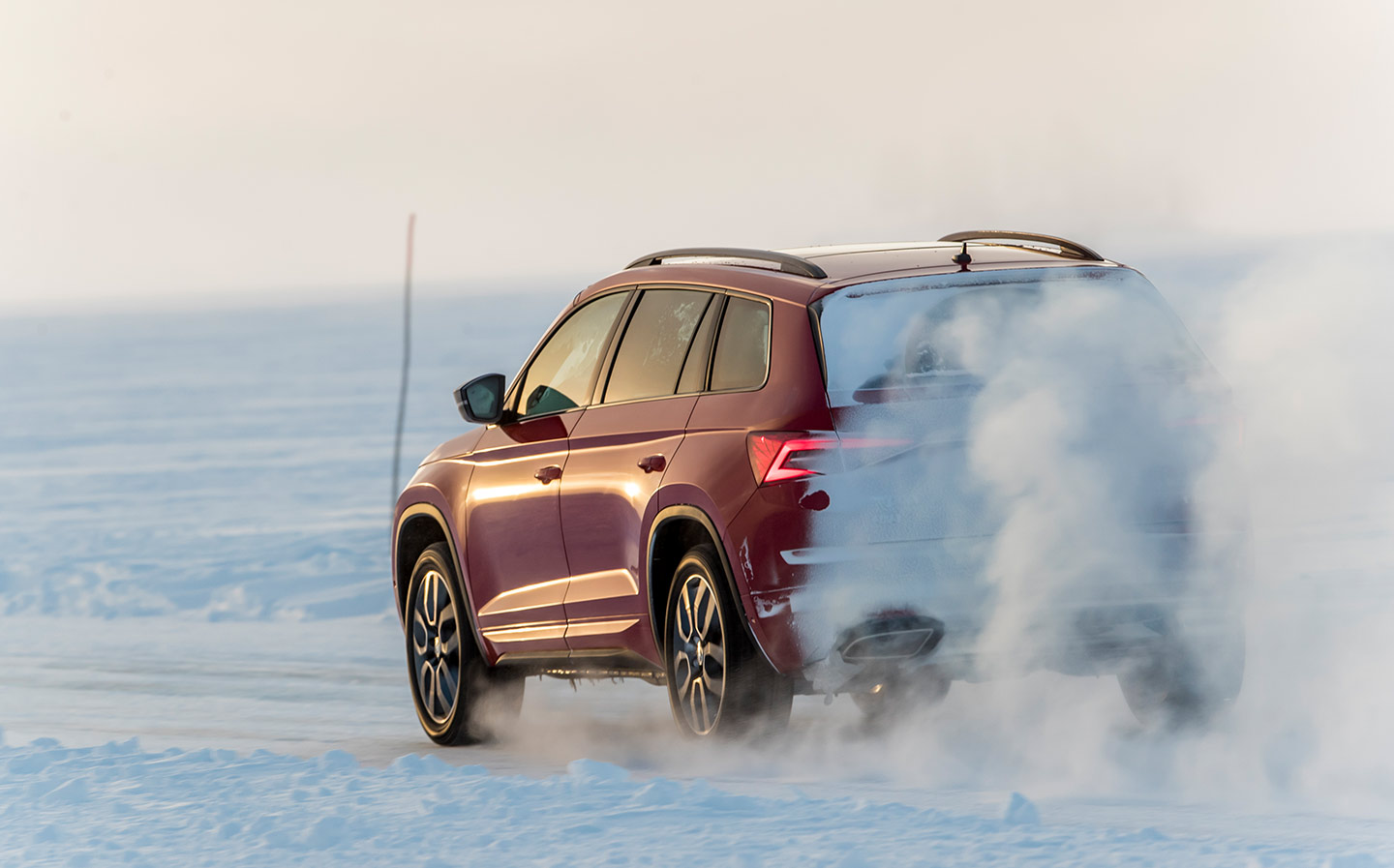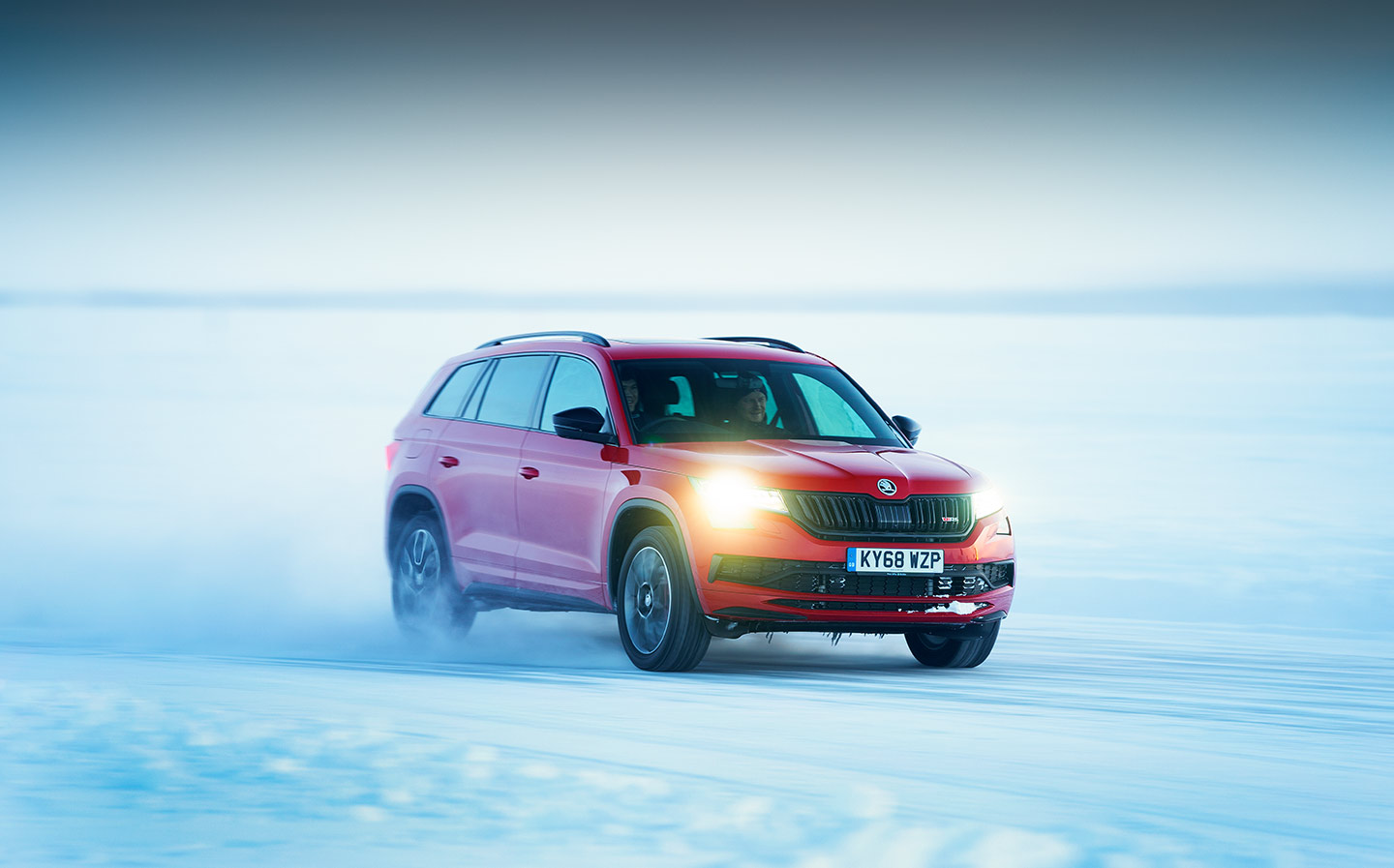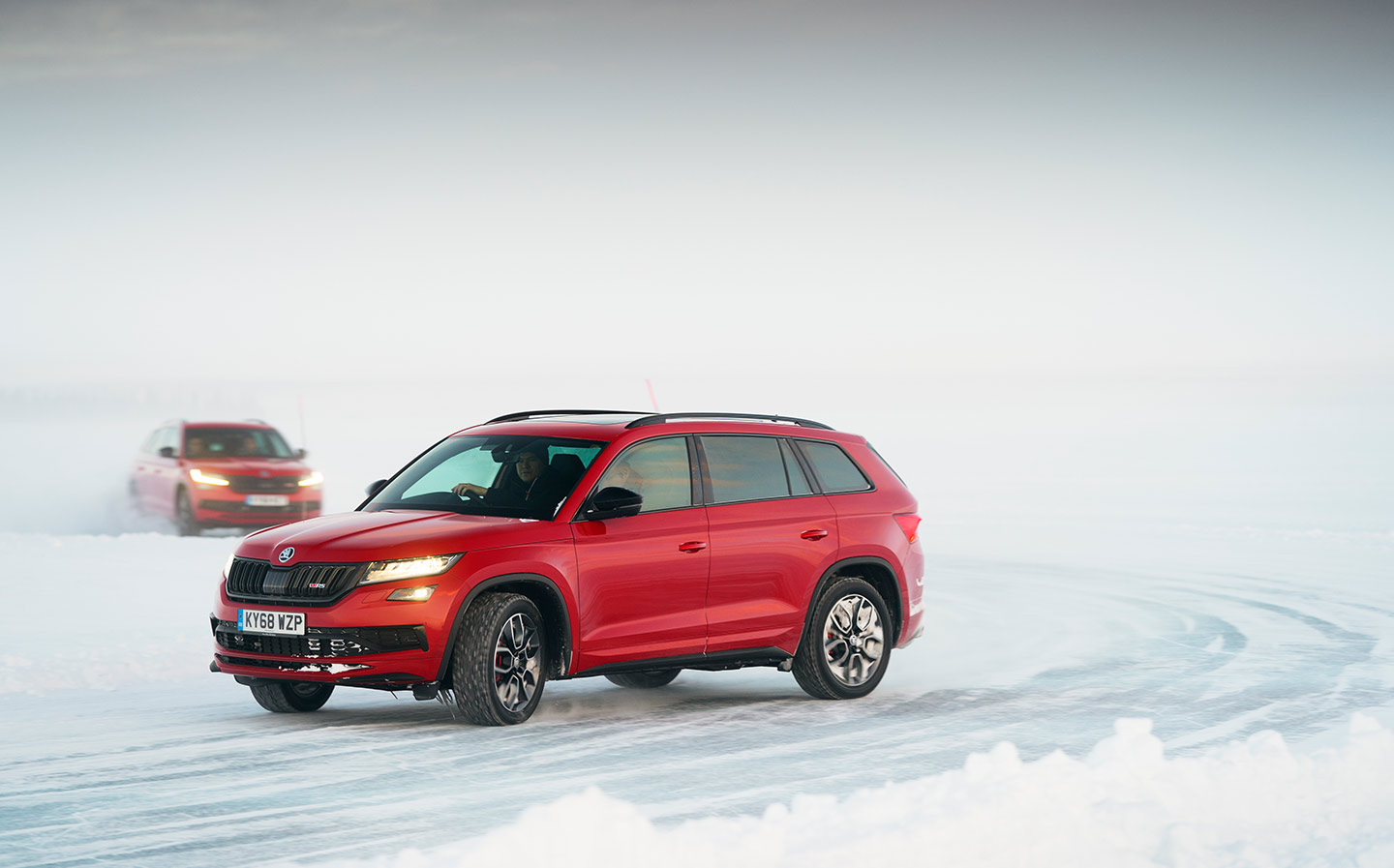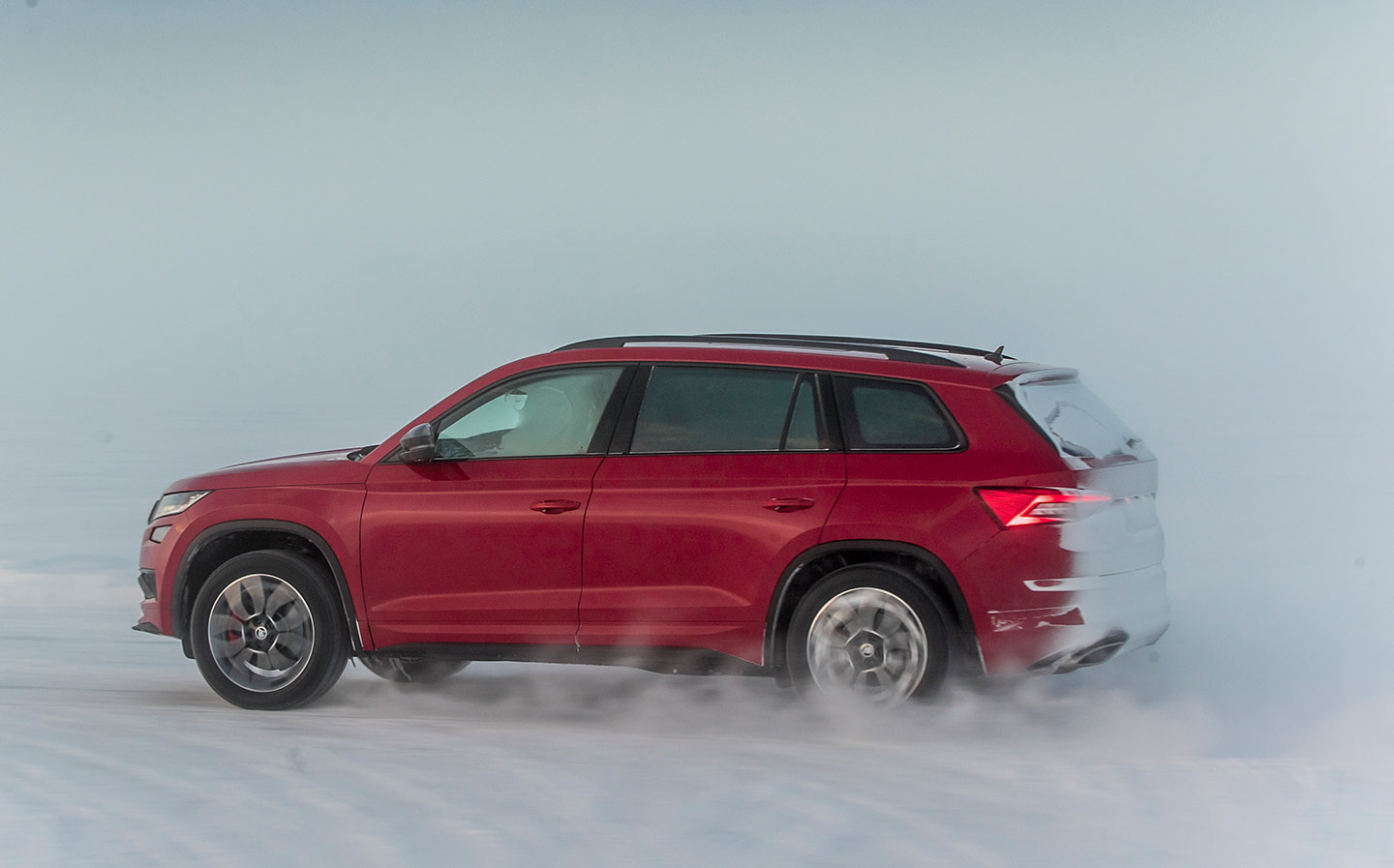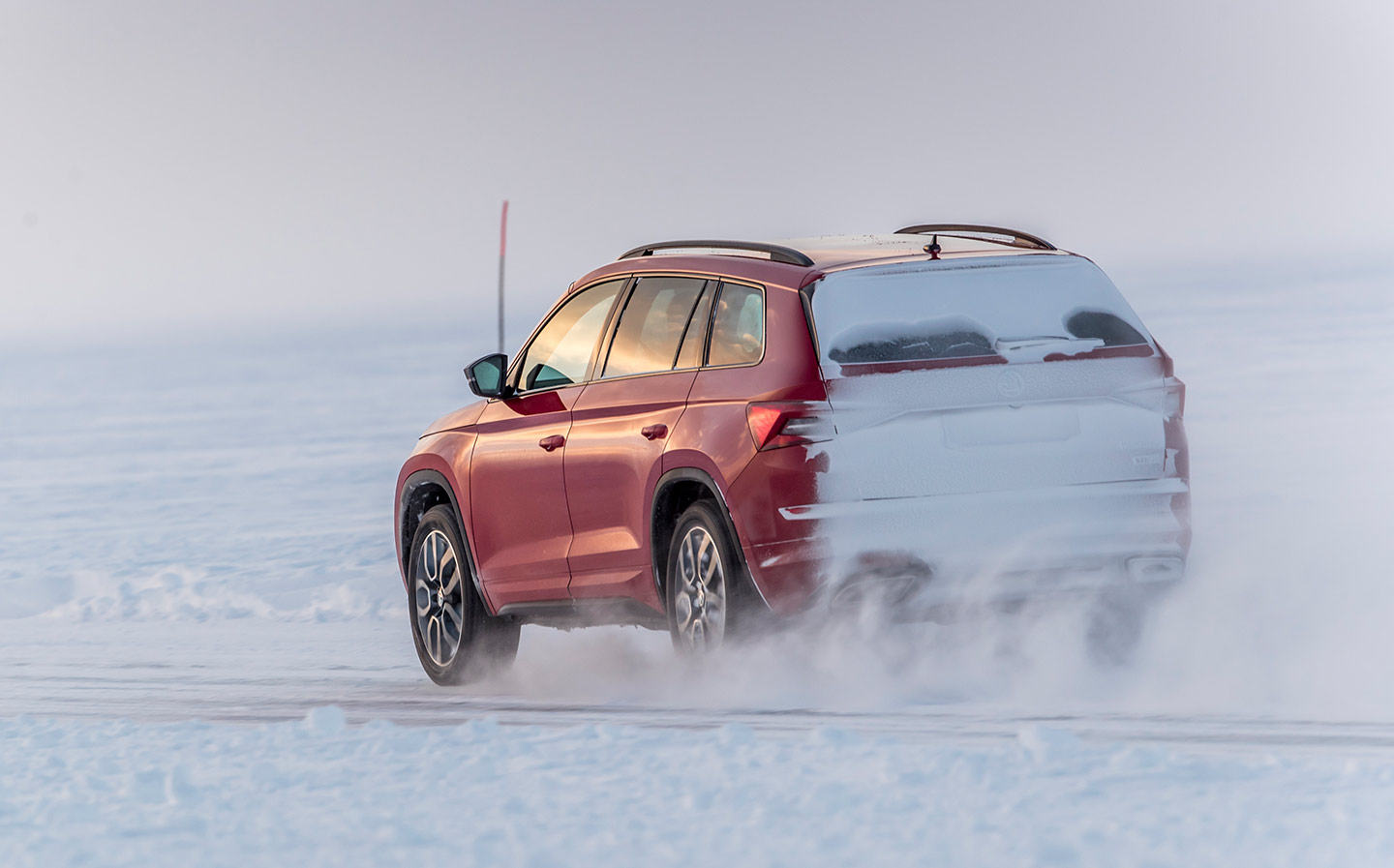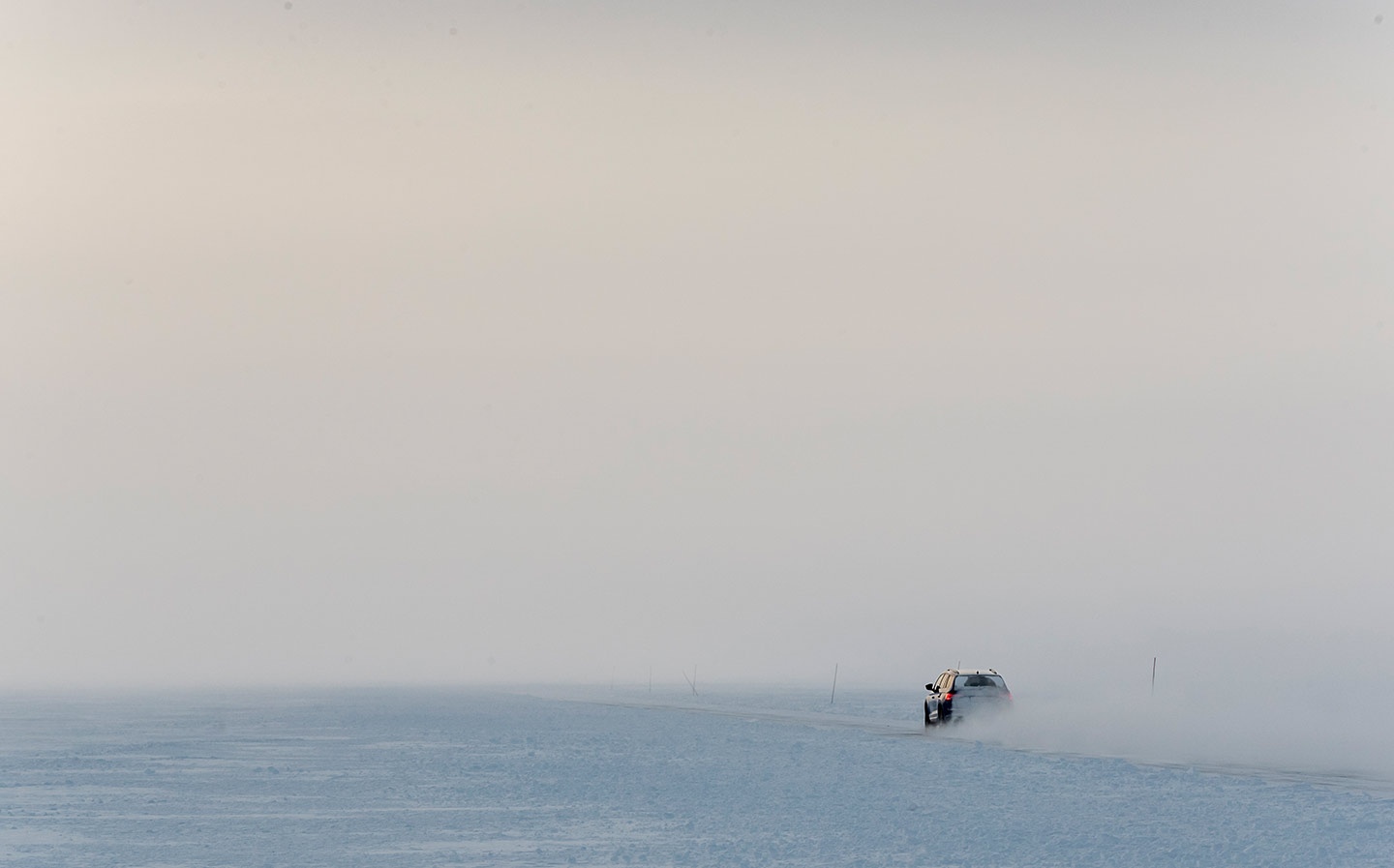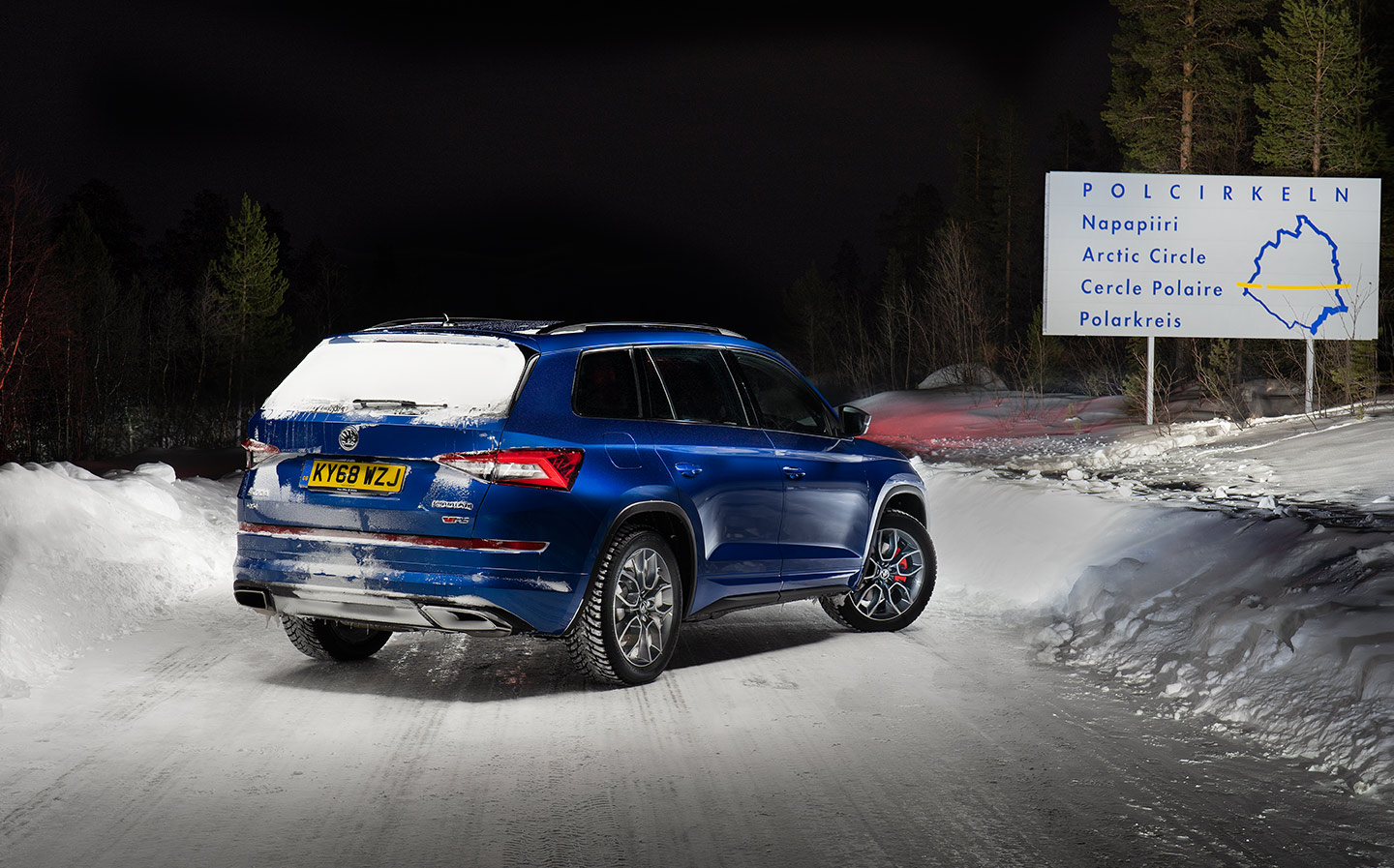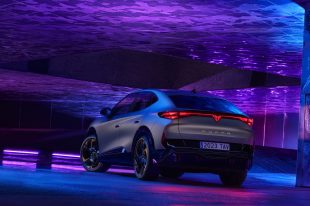Skoda Kodiaq vRS: ultimate test on track and ice (video)
Flat out at Silverstone ... and 'Slitherstone'
– Can’t see the video? Click here –
IT’S FASCINATING that the first of Skoda’s SUVs to carry its sporty vRS badge is the Kodiaq, the largest in the range. Even more so that the vRS only comes with seven seats, whereas you can get the standard model with five.
That should give you an idea of who this car is aimed at, and what sort of duties it will be performing; we’re talking blasts to Cornwall or the Alps with the family more than track days.
Also of note is that all Kodiaq vRSs come with Skoda’s latest four-wheel drive system as standard. That means when the going gets slippy, this car should find grip. With each wheel able to take up to 85% of the power independently, even drivers who wouldn’t consider themselves terrifically adroit behind the wheel should be able to keep the thing pointing in the right direction, whatever the conditions.
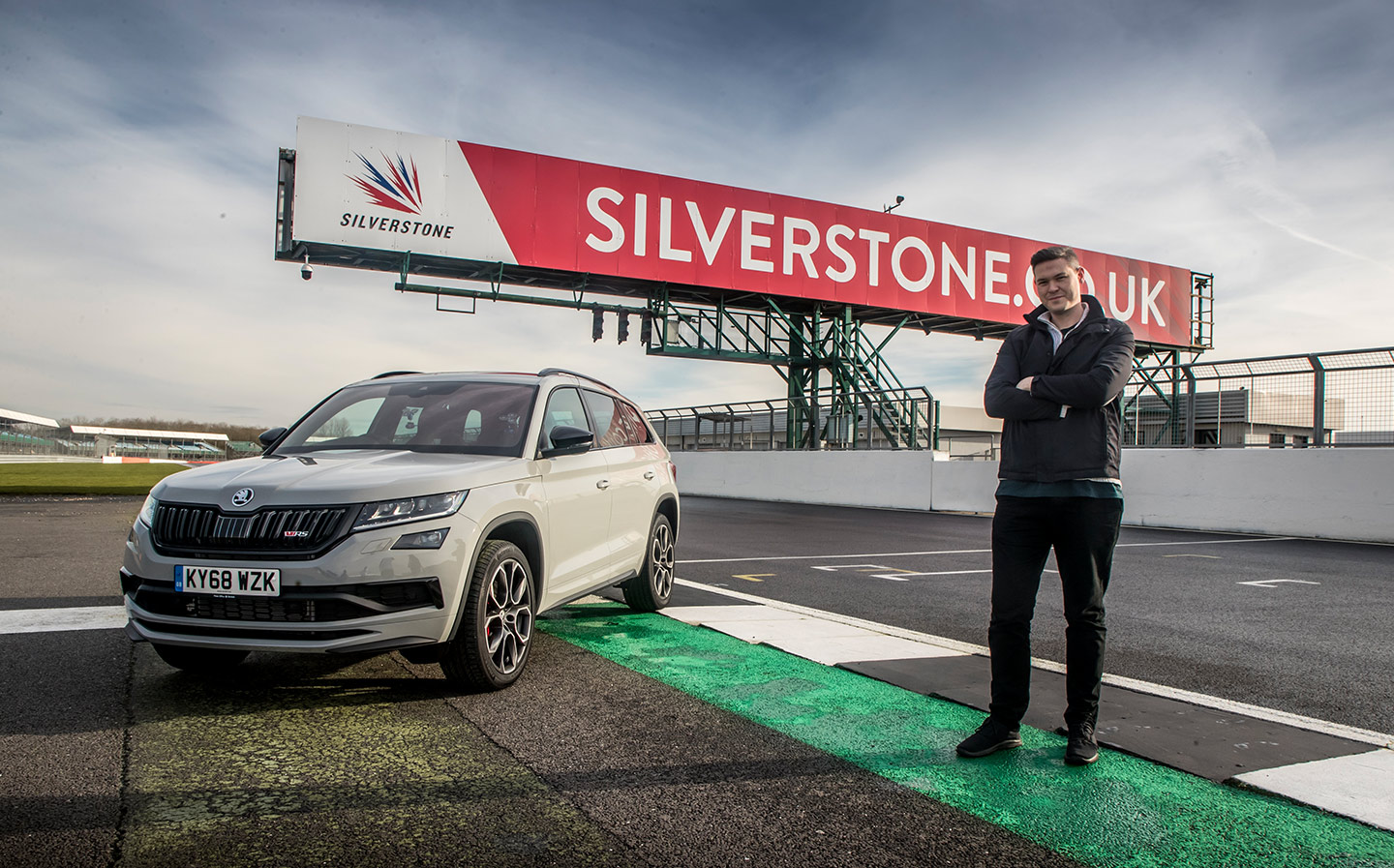
Which is possibly why Skoda thought nothing of flying a group of journalists out to northern Sweden to try out the car on sheet ice. And to ram home the versatility of the car, we also got to play with it for 45 minutes at the Silverstone circuit, one of the fastest on the F1 calendar.
Not the shortened National or International circuits, either — the full fat Grand Prix track, allowing us to tackle the mighty Copse corner and legendary high speed left and right sweeps of Maggotts and Becketts like proper Lewis Hamilton wannabes.
If you’ve already read reviews of this car then you might have been told that the vRS badge writes cheques that the 237bhp engine can’t match, and compared with SUVs in the Mercedes-AMG, Audi RS and BMW M stable, that’s true, but then you’ll need to fork out a lot more than the Skoda Kodiaq vRS’s £43,000 pricetag.
Comparable cars for power are the likes of the BMW X5 xDrive30d M Sport or Mercedes-AMG GLE 300 d, which also comes with seven seats. But although the Skoda’s interior can’t quite match the luxury of either, those models are also dearer, costing upwards of £14,000 more than the Skoda.
What’s more, as it turns out, the Skoda’s 2-litre, four-cylinder diesel engine — the most powerful diesel to ever grace a Skoda, in fact — is more than capable of hustling the best part of two tonnes around one of F1’s fastest circuits.
OK, our time on track revealed that a wedge more welly wouldn’t have gone amiss when blasting out onto the long Hangar Straight, but there’s ample power to fire the big Kodiaq from corner to corner through almost every other part of the circuit. That’s largely thanks to 369lb-ft of torque available from the diesel unit; more than that available from Skoda’s most powerful petrol engine, the 268bhp motor available for the Superb. Torque is all about that initial punch when you put your foot down, and this has plenty at almost any speed.
The vRS’s steering is surprisingly accurate, too, with the damp conditions on the morning of our test helping highlight the advantage of four-wheel drive. With the car in Sport mode (there are five other settings, including Eco, Comfort and Normal), the front end grapples for traction initially — understeer should be expected on a car as heavy as this — but that torque finds the right wheel within milliseconds and the car begins to rotate as requested, allowing you to hit your mark with impressive precision.
There’s some body roll, of course, but this is no pudding — Sport mode keeps the chassis relatively flat through the turns.
Skoda says a bit of drifting is even possible, but it’s not easy on a race circuit: you can unsettle the car by braking much too hard, transferring the weight to the front, and yanking the wheel (I was told to try this, and duly obliged), but a “drift” on Tarmac? Not really.
Having got a feel for the car over a few laps with an instructor issuing instructions like “OK, turn now… power, power, power” from the passenger seat, we brought out a stopwatch for a timed run. For the record, we lapped the 3.6-mile circuit in 3 minutes 11 seconds, but of course, without a point of comparison a lap time is about as useful as a chocolate teapot.
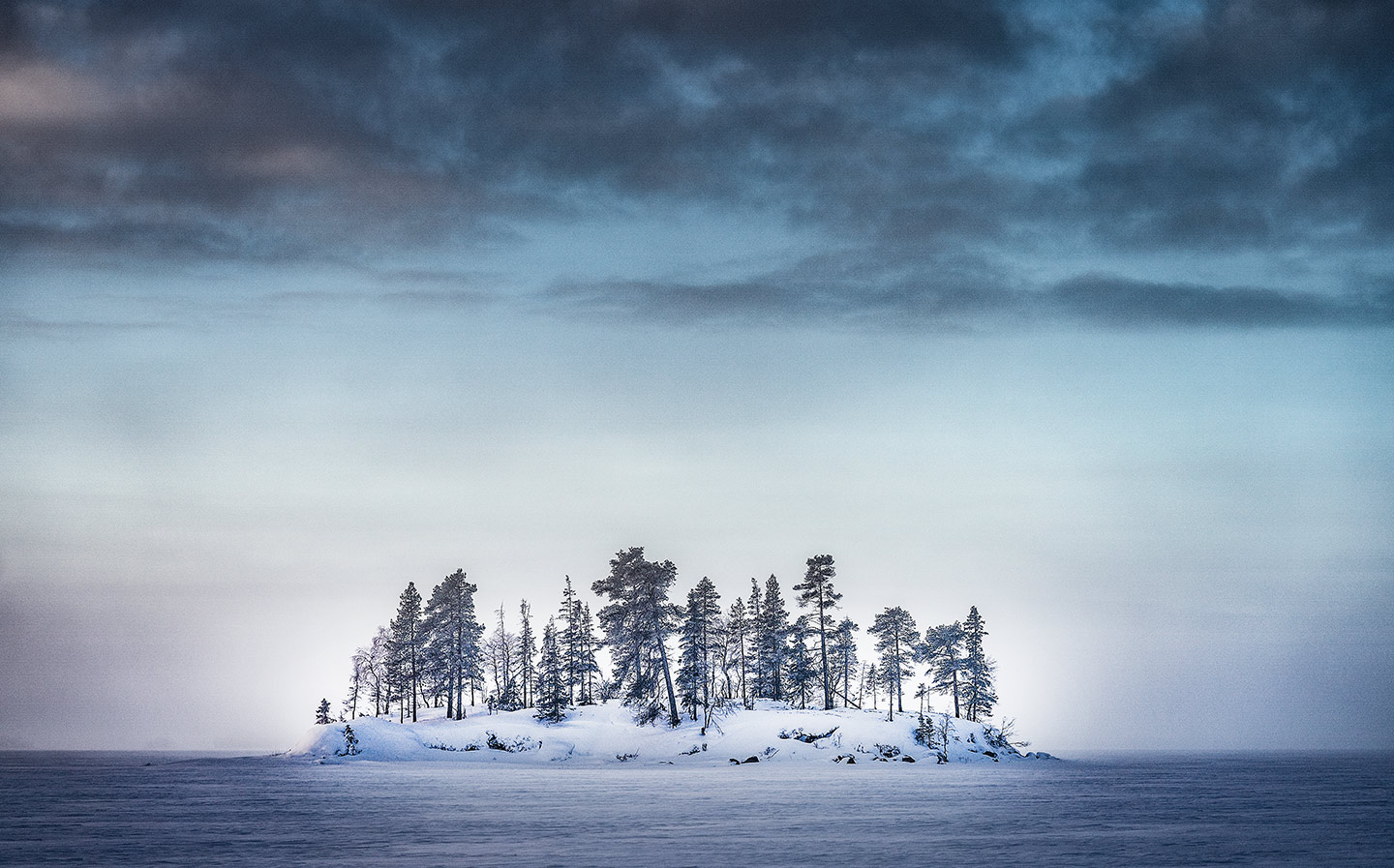
Which brings us to the second part of our trip: the Lapland Ice Driving facility, about 160km south of the Arctic Circle in Sweden. In this part of the world, temperatures dip well below freezing for up to seven months of the year, and in January the light is so fleeting that driving at 4pm might as well be midnight; it’s an eery, disorienting sensation.
But what fabulous scenery. Our venue was a vast frozen lake — an area large enough to accommodate seven Monacos, we were told — which freezes to a depth of up to a metre around October, with driving on the surface possible right through until April, when in the space of a week, the whole place returns to water.
Reassuringly, sonic devices are used to monitor the ice depth at regular intervals. Also reassuring was the temperature on the lake during our morning’s activities: -25C, which makes it extremely unlikely we’d end up taking a swim.
Carved into the huge facility are a number of tracks, including replicas of well known circuits at 1:1 scale. Paul Ricard, the Nürburgring and Yas Marina are represented, along with our setting for the day, Silverstone.
The idea: to set a second lap time, at this Silverstone on Ice. Or “Slitherstone”, if you like.
This was not a perfect comparison for a number of reasons. For one, what were rumble strips at the UK track were instead piles of thick snow in Sweden. Also, the track carved out on ice was the old Silverstone, including the Farm, Abbey and Bridge corners, rather than the new layout GP track we had driven back home.
And anyway, what sensible conclusion could we glean form comparing the times? That the car is slower on ice than on asphalt? Wow, what a insightful conclusion that would be.
These points aside, it was a fascinating exercise in getting to know the Kodiaq vRS’s handling characteristics. As most rally drivers will tell you, you can learn more about car control in five minutes on ice than you can in five years on dry road. By extension, you can also learn a huge amount about a car’s on-limit handling traits in five minutes, too.
For example, flicking between the vRS’s Normal, Sport and Snow modes highlighted nuances that would be barely detectable back in the UK.
Our cars in Sweden were fitted with studded tyres but even so, sheet ice is slipperier than an oiled eel. Getting sideways is possible in any mode but it was immediately clear that Sport mode made the back end much looser, and with a bit of guidance from an expert at ice driving, this was the mode for the fastest progress, while Snow mode made the car much easier to control in these treacherous conditions.
The difference was mainly in the weight and responsiveness of the steering and throttle. Snow mode weighted up the steering to encourage less erratic movements, while a duller throttle and much-reduced wheelspin helped improve traction.
Sport mode was more fun, with plenty of wheelspin making for more dramatic slides, but too much power too early and the car simply slid to the outside of the corner (and beached in the deep snow, as a few of my colleagues discovered). Smooth inputs from the driver are even more key in the big, high-sided Kodiaq than in a low, rear-drive sports car, and patience proved a virtue.… brake, flick, feather the throttle until the back end slides round, then wait… wait… wait, until the car has rotated enough, then nail the throttle to hold that angle for the exit.
Normal mode? That had a lighter feel to the wheel, while providing a balanced throttle somewhere between Snow and Sport.
The most impressive part was the braking. We hit 106mph down the icy version of Hangar straight before slamming on the brakes into the 90-degree right-hander of Stowe. Gone are the days when cars would simply lock the wheels and keep sliding, or worse, send you into a high-speed spin. With anti-lock braking and its electronic stability control, the Kodiaq kept dead straight and, with much help from the studded tyres, of course, scrubbed off speed amazingly quickly. Down to around 30mph, a quick flick of the wheel and we were sideways through Stowe, all under control.
The main takeaway was that the Kodiaq vRS remained eminently controllable on even the loosest of surfaces. Even more impressive is that not once did I end up facing the wrong way, even when pushing hard. Nor did I see any other reporter doing a 180 or 360 spin.
The Skoda works incredibly hard at keeping you on the road and pointing in the right direction, which is great news for anyone who dreads long motorway trips in pouring rain, or those few weeks each year when snow brings what tabloids call “chaos to the UK”.
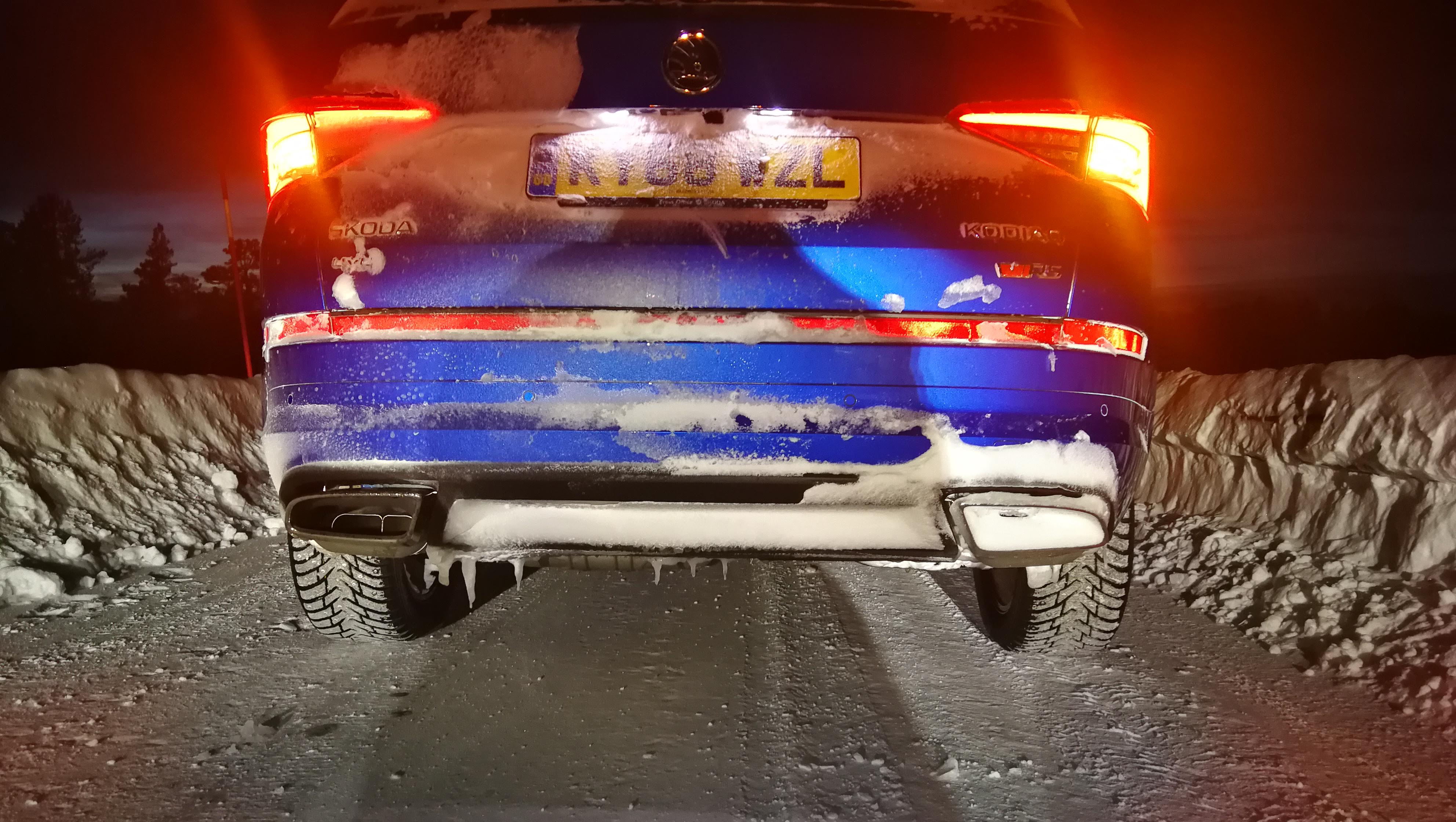
Bad things? Well, the twin exhausts aren’t twin at all — there is no right-hand pipe so the chrome trim on that side is purely there to make it look more sporty and bring symmetry to the rear of the car. This was a point made all the more apparent in Sweden, where the non-exhaust filled with snow and ice while the real one remained frost-free, due to the heat.
And there was a slight delay in power delivery at low speeds when power sliding on ice in Sport mode; the car clearly wanted me to take it a bit easier in those conditions.
Also, in both the UK and Sweden I managed to accidentally trip the voice control button on the steering wheel while turning the wheel in anger, with the inside of my left hand. Maybe the button is awkwardly placed or maybe I have weirdly fat hands; the jury is out.
There may also be differing opinions on Dynamic Sound Boost, a synthetic engine sound that’s pumped into the cabin (and outside the car) to make it sound more V8-ish. It’s not gone down well with the press but I have a feeling some customers may quite like it.
And as mentioned earlier, one other sticking point might be the price: £42,870. But again, sports-focused seven-seaters aren’t exactly prolific and true competition for this kind of vehicle is more expensive right now.
What’s more, Skoda tells us most Kodiaq buyers opt for higher spec versions, with average prices around £35,000, when options are factored in. That’s why a new luxury L&K model is being introduced. From there, it’s not a huge leap to the vRS’s £43k, especially when you consider it comes fully loaded with tech like a digital dashboard and adaptive suspension, smart sports trim and a well-appointed interior.
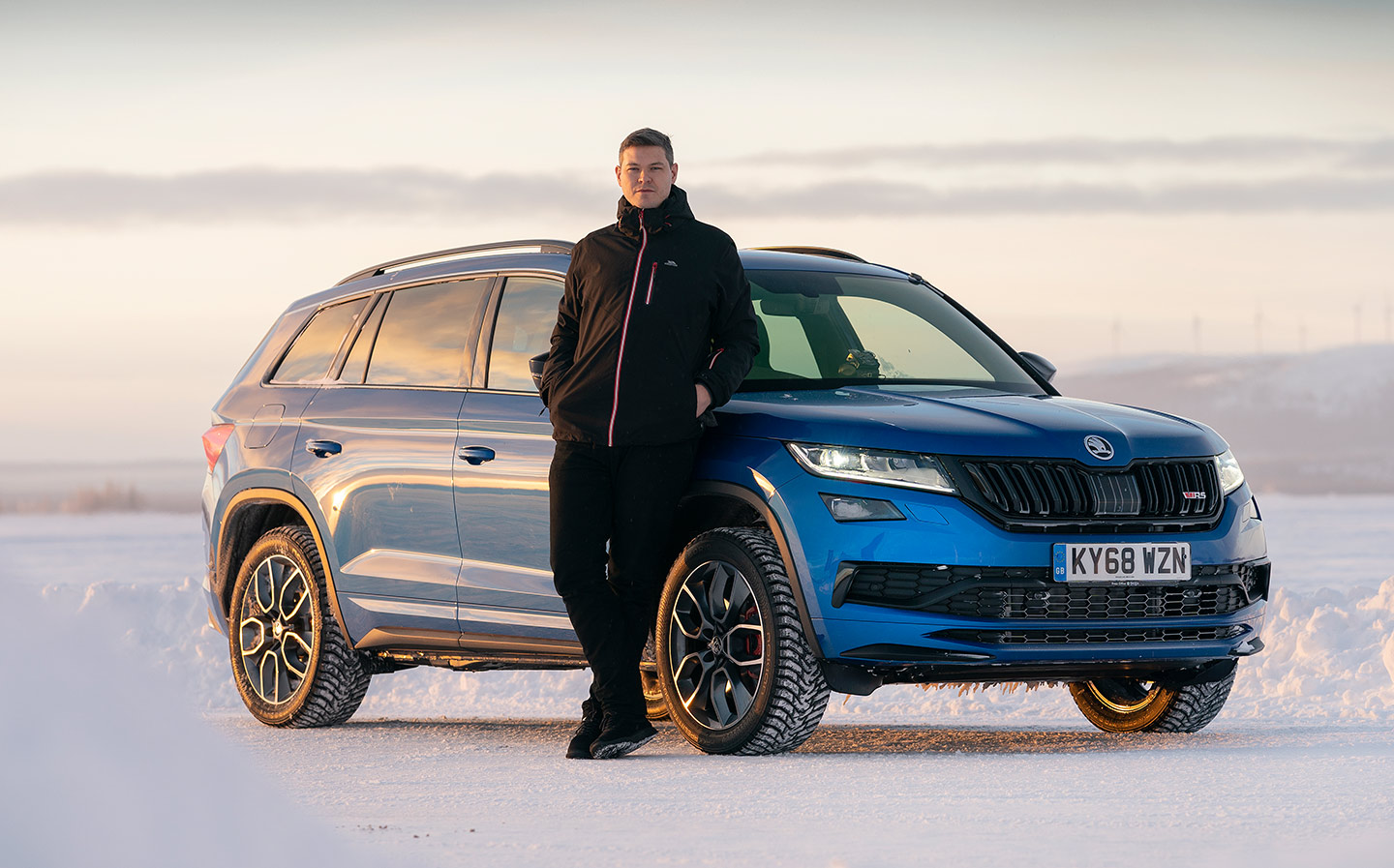
At the end of the day, the Kodiaq vRS proves to be one of the most versatile vehicles currently on sale in the UK — fun when you want it to be, safe when it’s needed, and with a cavernous interior.
Its amazing versatility was highlighted during a short excursion to the edge of the Arctic Circle itself. While waiting for a photoshoot involving another car to take place, in the pitch black of 4.30pm and a temperature of -21C, my driving partner and I were cocooned in the car, with heated seats and a cabin set to a comfortable +21C, while the best of David Bowie was streamed from a smartphone via the Kodiaq’s excellent sound system. Given the extreme environment around us, it really was quite a surreal moment.
And if you wanted to know what my lap time was on snow: 4 minutes 17 seconds. So, cars really are slower on ice … you heard it here first, folks.


